How to Do the Incline Bench Press for Upper-Body Size and Strength
Some lifters hail the classic barbell bench press as the king of the upper body lifts, but its cousin the incline bench press could be a serious contender for the throne. Unjustly frowned upon in favor of the flat version, the incline bench press should be a staple for most lifters.
Credit: as-artmedia / Shutterstock
In fact, it is a more efficient version for many sports athletes. Just like the classic flat bench press, the incline bench press allows you to increase your pressing power in a functional and athletic way. You’ll also add size to your chest, shoulders, and arms.
Does using an incline really make a difference? Yes. Here are all the reasons why.
How to Do the Incline Bench Press
The incline bench press is a fundamental exercise that can be beneficial to every lifter. As a multi-joint, free-weight exercise, proper technique is paramount in order to reap the many benefits while minimizing the risk of injury.
Step 1 — Set Up on the Bench
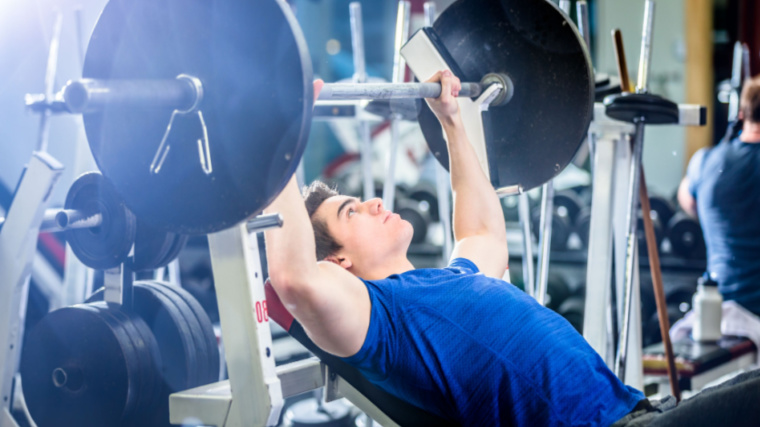
Lie on a bench set to an inclined angle. Most gyms are equipped with fixed incline bench press stations. You can also setup an adjustable bench in a rack, which can allow you to use different angles for diverse muscle recruitment.
Adjust the seat position so the bar is above your eyes. You should be able to reach the bar with nearly straight, not significantly bent, arms. “Pack” your shoulders by pulling them back and down, which should arch your chest slightly up. Put your feet flat on the ground and tense your legs for stability. Grab the barbell with a pronated (palm-down) grip, slightly wider than your shoulders, and squeeze the bar hard.
Form Tip: Your grip width will play a role in muscle recruitment. A wide grip (well-beyond shoulder width) will target the front shoulders and overall chest, whereas a more narrow grip (equal to shoulder-width) will hit the triceps and upper chest more significantly. (1)
Step 2 — Unrack the Barbell
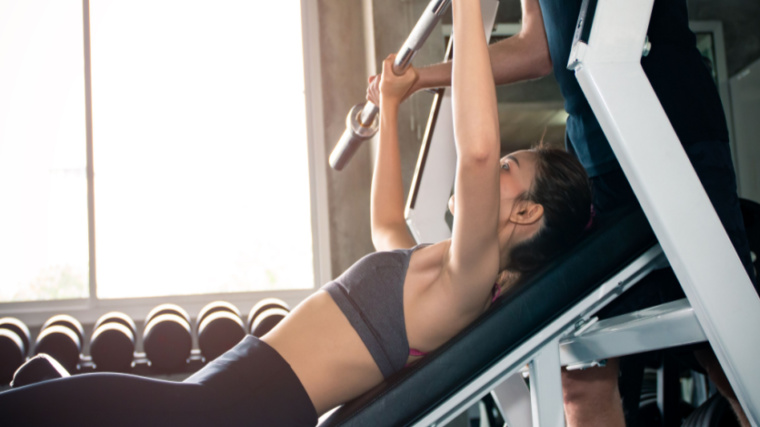
Maintain tension through your whole body. Without moving the bar, try to bend it like a horseshoe. This helps to engage your lats and increase upper-body stability. Push your feet into the ground, as if you’re trying to slide the bench backwards. Take a deep breath and hold it as you flex your core during the lift-off.
Straighten your arms to lift the bar off the support hooks. “Pull” the bar to line up above your shoulders with your arms fully extended.
Form Tip: Only your arms should move during the lift off. Keep your scapulae (shoulder blades) together and down to protect your shoulder joints. If the bar is set too low and you need to perform a long range of motion to unrack the bar, you’re more likely to lose a stable position.
Step 3 — Lower with Control
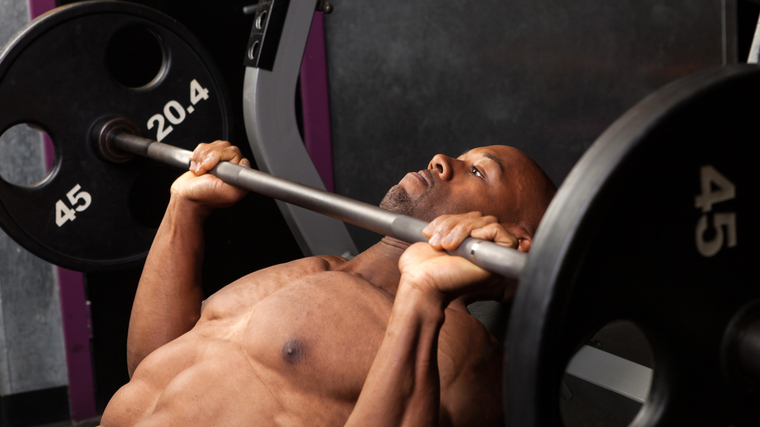
Lower the bar towards your upper chest or collarbones by bending your elbows. Maintain full body tension. Aim your elbows at an angle between your feet and shoulders. Keep your wrist upright, without tilting your hand forwards or backwards. Keep your forearms vertical and your elbows directly under the barbell.
Use a directly vertical bar path and lower the bar to touch the same spot on your chest with each repetition.
Form Tip: If you have stiff shoulders or upper body mobility issues, the full range of motion may be uncomfortable or even painful. If this is the case, work in a pain-free range of motion and stop a couple of inches before touching your chest. This should reduce stress on your rotator cuff and shoulder stabilizing muscles.
Step 4 — Drive the Weight Up Explosively
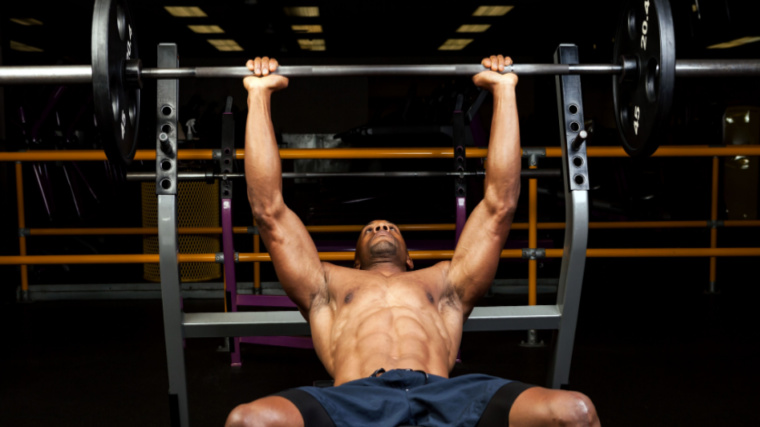
From the bottom position, press the bar up as explosively as you can without being reckless. Keep tension through your body. Exhale as you drive the bar with force. Push steadily through your feet until the rep is complete, because the leg drive will transfer to your upper-body stability and power.
The barbell should end up over your shoulders, where it began after being unracked. Your arms should be locked and perpendicular to the floor.
Form Tip: Do your best to hold your breath until the sticking point (hardest part) of the movement is completed. This is most often near the transition from lowering the weight to pressing it up. Releasing your breath too early might cause your chest to cave in, resulting in a loss of total-body tension.
Incline Bench Press Mistakes to Avoid
The incline bench press is a relatively less technical animal than its flat bench counterpart, but flawed form is still a common sight in many gyms. Here are the main mistakes to avoid in order to progress efficiently and safely.
Flaring Your Arms
The incline bench press can put a lot of strain on the shoulder joint and greatly stretch the chest. In order to diminish this risk, you have to ensure optimal form at all times.
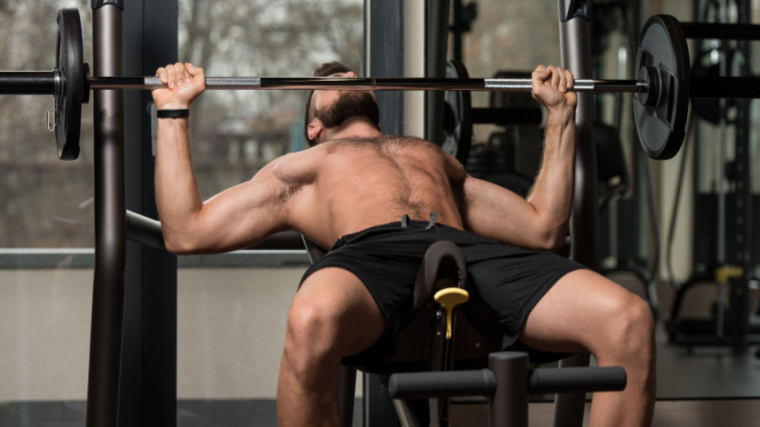
Monitor your elbows. Do they flare out towards your shoulders when you press the weight up? If so, you’re putting a lot of stress on your joints. Moreover, this position is less optimal for force production and you won’t develop as much strength.
Avoid It: Keep your arms around a 45-degree angle to your body. The exact angle will depends on your individual anatomy and bone length. Be sure to imagine “bending the barbell in half” because it will engage your lats and help prevent the flaring.
Bringing the Bar Too Low on Your Chest
Unlike the flat barbell bench press, in which you lower the bar in a slight arc, the incline bench press is most effective when you keep the bar path straight and vertical. It means that the bar should stay over your upper chest at all times and never drift towards your stomach.
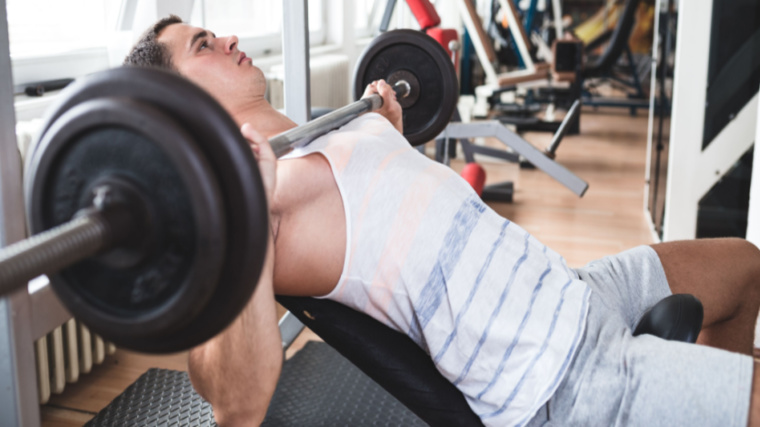
Using a lower bar path will not only be detrimental to force production, but it will also rotate the shoulders into a weak position, which increases the risk for injury and decreases muscle tension.
Avoid It: Keep a vertical bar path by always having the bar approach the same spot on your chest for each repetition. Your wrists should be positioned vertically over your elbows vertically.
Lifting Your Feet
Unfortunately, many pre-set incline bench stations have steps or pegs where you can put your feet. Don’t use them. Unless, of course, you have a specific lower back condition that prevents you from comfortably and securely placing your feet flat on the floor.
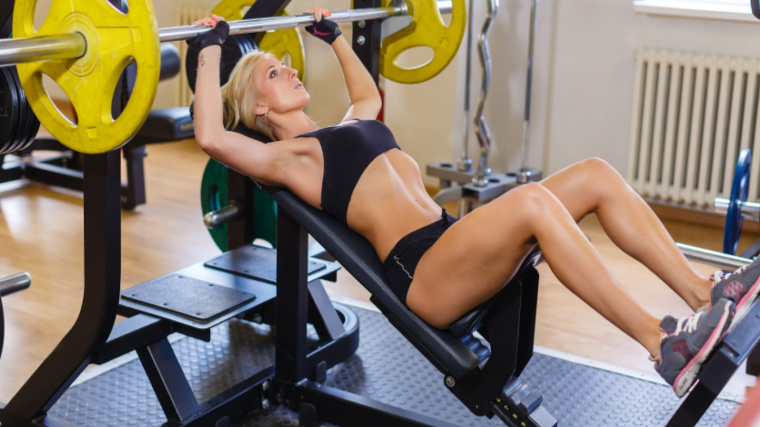
In order to press with power, you need a strong and stable base. Planting your feet on the ground and flexing your legs will produce more tension and stability throughout your entire body, which transfers into the lift.
Avoid It: Bring your feet almost under your hips and apply pressure into the floor for the duration of the lift. Push as hard as you can through your toes, as if you wanted to push the bench into the wall behind you. This leg drive will transfer stability to your upper-body, and ultimately the bar, allowing you to lift more weight.
Benefits of the Incline Bench Press
The incline bench press, being a slight variation of its flat counterpart, offers many of the same benefits. Both exercises load the upper body with relatively heavy weights while developing size and strength, but the incline brings its own set of results.
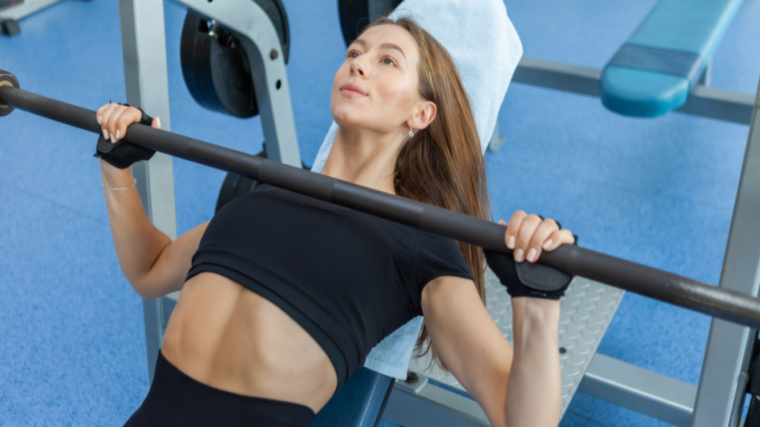
Whether it’s added to a later part of the workout or prioritized on its own, the incline press offers distinct advantages.
The Best Upper-Chest Builder
For a complete, aesthetic chest development, you need a well-developed upper chest. Any type of incline over overhead press will recruit the clavicular (upper) head more than the sternal (mid-chest) muscle, but nothing trumps this movement for specifically building upper chest size. If that body part is lagging, you should make the incline bench press your main pressing exercise.
The angle of the bench is hugely important. A steep angle will target more the anterior deltoid (front shoulder) as well as the clavicular portion of the chest muscle. For overall chest development, a moderate incline of 15-30 degrees has been shown to be highly effective. (2)
Improved Athletic Performance
In many cases, the flat bench press isn’t the best bet for athletes because you rarely, if ever, press in a directly horizontal motion during sports events. Take rugby or American football, for instance. Your arms have to press at an angle relative to your torso if you want maximum efficiency and power. Athletes can use the incline bench to improve their on-field performance, as well as diversify their pressing strength and address muscle weaknesses.
Increased Upper Body Size and Strength
The incline bench press is one of the best investments you can make to pack on muscle and strength. Because you recruit the chest, shoulders, and triceps, you can use heavier weights than many upper body pressing exercises. This delivers a superior stimulus and you’ll progress more quickly and become stronger than with many other pressing exercises.
Muscles Worked By the Incline Bench Press
The incline bench press is not a single-joint isolation movement, so it will work all the pressing muscles of the upper body. As such, it is one of the best ways to develop these essential muscles for both beginners and experienced lifters.
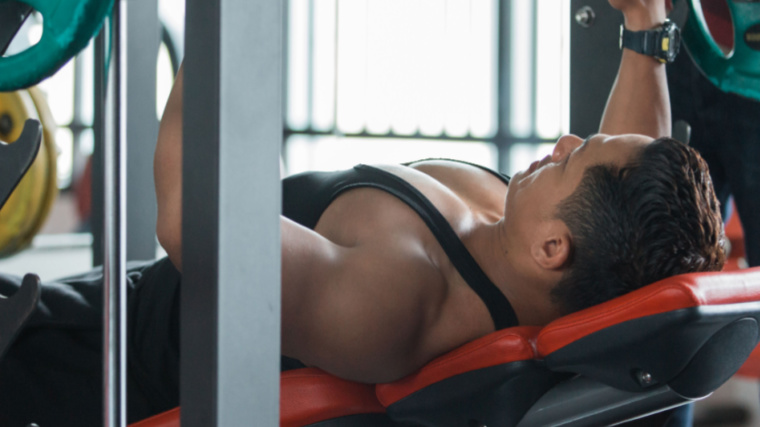
The incline bench press is sometimes seen as a “hybrid” between chest exercises and shoulder exercises because the incline angle alters muscle recruitment in the pressing muscles. This can be used to your advantage when programming the exercise for your specific goals.
Pectoralis Major
The pecs are the main and the largest chest muscles. Their function is internally rotate the humerus (the upper arm bone) as well as adduct it (bringing it closer to the body). This last function is mainly responsible for the incline bench press motion. The pectoralis has two main heads, the sternal (mid and lower chest) and the clavicular (upper chest). The incline bench press develops the chest as a whole, but will put more emphasis on the clavicular head than the flat version.
Deltoids
The deltoids are the shoulder muscles, composed of three heads: the anterior head (front of the shoulders), the lateral head (middle of the shoulder), and posterior head (rear of the shoulders). Their function is to raise and rotate the arms in their corresponding directions. Because the arms are in front of the shoulders during the movement, the anterior deltoid will be hit the most. As the pressing angle gets more steep and approached upright, your mid and rear delts will contribute more to the movement. (3)
Triceps Brachii
This is the muscle sitting on the back of your upper arm, responsible for extending and straightening it from a bent position. The triceps are essential to every pressing movement and will contribute greatly to the lockout portion of the incline bench press. They are more heavily activated if you use a closer grip width and/or a steeper angle.
Back
The lats and upper back muscles are involved in supporting the incline bench press, even though they really aren’t prime movers in this movement. They do contribute to its execution. The latissimus dorsi (lats), the largest back muscle, mainly serve as a shoulder joint stabilizer and will prevent your elbows from flaring.
The upper back muscles — the trapezius, rear deltoids, and rhomboids — support shoulder and scapular (shoulder blade) stability, allowing for proper force transfer. They are taxed more significantly during high-angle incline pressing.
Who Should Do the Incline Bench Press
This exercise is a staple for upper body pressing strength and size. It will serve experienced and beginners alike because it is as efficient and effective as the flat bench press. (4) Everyone from general athletes to strongmen and strongwomen and everyone in between can benefit from putting more emphasis on the incline than flat.
Strength Athletes
Strongmen, strongwomen, and Olympic weightlifters will benefit the most from incline benching. They need tremendous shoulder strength. Because the flat version is never seen in their competitions, the incline press is an ideal complement to direct overhead pressing. Powerlifters and CrossFit athletes can also benefit from using the incline bench press to improve weaknesses, such as the mid-range of the bench press for powerlifters or carryover to overall pressing strength for CrossFitters.
This lift will greatly build overhead stability and force production, so any athlete or lifter that wants to move heavy weights overhead should consider it.
Athletes in Contact Sports or Track and Field
Strong shoulders are a staple for these athletes and the inclined angle is more sport-specific to their activities. Whether it’s throwing punches, throwing a discuss, or throwing a ball, the incline bench press a superior and more relevant alternative to build transferable pressing strength because their sports rarely involve direct overhead or direct horizontal pressing. It’s also a good way to add variety to training, prevent overuse injuries, and shape a complete athlete.
Regular Gymgoers
Most lifters learn to prioritize the bench press, but adding a little variety certainly won’t hurt the non-competitive gymgoer and it will provide a fresh training stimulus. It’s as effective for building size and strength, and it’s typically believed that having well-developed shoulders (from the added incline training) will shape your frame in a more aesthetic way. The incline bench press will prove a fantastic variation to anybody who wants a bigger, broader, physique.
How To Program the Incline Bench Press
The incline bench press is a formidable choice to improve strength and size because a variety of training schemes can be used. Low reps with heavy weight or relatively lighter weight with high volume — you decide depending on your objectives. In any case, you should perform the incline bench press when fresh in a session, as the first or second exercise of the workout, to apply the most focus and effort.
Heavy Weight, Low Repetitions
If you want to build maximum strength, this is the way to go — three to six sets of three to five repetitions. If you’re experienced, you could even use heavier weight for two or one repetitions. Keep one or two reps in the tank to ensure proper form at all times because technique is crucial in developing strength. (5) In the same spirit, use long rest periods of three to five minutes so that you can repeat the same effort and your form doesn’t degrade.
Moderate Weight, Moderate Repetition
If you want to build size, three to four sets of six to 12 repetitions is your best bet. You should still keep perfect form at all times, but approach, or even achieve, muscular failure on each set. Rest periods should be two to three minutes long if you want maximal results. (6) Use the lower end of the rep range with a longer rest the majority of the time. But consider shortening the rest to 60 to 90 seconds with higher reps if you want to enjoy a nasty pump.
Moderate Weight, Low Repetitions
This approach should interest athletes. Roughly six to eight sets of two to five repetitions is excellent for building explosive strength and power. This is the least efficient scheme for building muscle, but it will improve your speed, power, and technique. Use a moderate weight that you can accelerate and press it as fast as you can. You should never feel fatigued or approach muscular fatigue, so keep your rest periods between one to two minutes to keep your nervous system fresh. Resist the urge to rest less.
Incline Bench Press Variations
You want to add incline pressing to your training regimen, but the barbell hurts your shoulders? You don’t feel your chest working? You crave new exercises? Don’t worry, you’re covered with these variations that can add variety while still developing incline strength and building chest, shoulder, and arm size.
Dumbbell Incline Bench Press
If you have upper back or shoulder mobility issues, the barbell incline bench press can sometimes force your shoulders into a compromised position. This can strain your joints and and potentially cause injuries if you suffer from shoulder impingement or a poor subacromial space (the area between where your humerus connects to the shoulder joint). If barbell pressing is painful, try the dumbbell version.
You won’t use as much total weight, but the freedom and range of motion allowed by the dumbbells ensures less stress on the shoulder joints. It can actually be an even more efficient way to target your chest muscles. (7) Plus, as a unilateral exercise (making each side of the body work on its own), it is a great way to address muscle imbalances.
Decline Push-Up
Let’s go back to the bodyweight basics. This push-up variation can be done anywhere, at any time, and does not need equipment other than something to prop your feet onto. It’s essentially a traditional push-up with your feet elevated, on a bench for example, to mimic the incline angle. Keep your body in a straight line. Support yourself on your hands and toes, and do not let your elbows flare out.
This is a harder variation of the standard push-up. As an unweighted bodyweight exercise, it will be best used for higher reps with shorter rest periods. It’s the same principle as with the bench: the higher your feet, the more challenging the exercise will be and the more you’ll recruit the shoulders.
Incline Pin Press
The low end of the range of the incline bench press can be an issue for some lifters, since it’s the position where the muscles and joints are under the greatest stretch. If it’s painful or problematic, why not avoid it? Set pins in a rack so that the barbell is just a couple of inches over your chest to limit the range of motion. Lower the bar to gently contact the pins on each rep to ensure the same range of motion on every rep.
As a bonus, let the bar rest in a dead-stop for one to two seconds before pressing each rep back up. This will elicit tremendous muscle activation and help develop both tightness in the lift and explosive power.
Incline Bench Press Alternatives
If you train in a home gym without an adjustable bench, or if they are all taken because it’s Monday evening and everyone in the world is training their chest, don’t panic. Here are some alternatives to work the same muscle groups and provide almost-similar benefits.
Bench Press
As expected. The bench press being (arguably) the king of upper body pressing exercises, it is a natural choice if you cannot perform the incline bench press. It offers many of the same benefits, though it works the middle part of the chest more and the shoulders less.
This is the pressing movement with which you’ll most likely use the most weight, so it is a fantastic overloading movement to increase strength and size, and can be a staple in many performance programs.
Floor Press
The original “bench press”, originally performed before flat benches were in gyms, is a very good substitution for the incline. It’s very simple: you lie on the floor and press from there, either taking the weight from pair of low-set safety pins or carefully hip thrusting the weight into the lockout position to begin. Lower the bar slowly so you don’t smash your elbows into the floor, pause for a second, and drive up hard to lockout.
Because it uses a partial range of motion compared to lying on a bench, it will emphasize your triceps and lockout strength while avoiding stress on your shoulders. As such, it is a great variation for experienced lifters who’ve developed poor shoulder joints over the years. It also has the particularity of not using the legs — just like on the incline, you cannot cheat.
Seated Shoulder Press
Do you want cannonball delts? Done. Take the incline to the extreme — completely vertical. This variation hits the shoulders way more as a whole, but still works the clavicular portion of the pectoralis. If you want a bit more chest activation, use a slightly-less-than-vertical angle, anywhere from 60-degrees to 85-degrees will do the job.
It is not a bad idea to rotate more shoulder-focused exercises in your routine because this muscle group is usually a weak link both in aesthetics and performance.
Smith-Machine Incline Bench Press
The Smith Machine is an often overlooked piece of equipment which can provide great muscle-building benefits. This is a nearly identical variation as the barbell incline bench press, but the Smith is more geared towards hypertrophy instead of strength because it cannot safely accommodate very heavy loads.
The Smith machine requires much less stability and can push yourself closer to muscular failure than with the barbell. Because you don’t have to recruit as many stabilizing muscles, it can be a good choice for beginners learning the movement pattern and basic technique.
FAQs
Can I do the incline bench press as my main chest exercise?
Indeed you can. It has been shown to be as efficient as the flat bench press for beginners. Many experienced lifters use the incline press as their go-to chest movement, including six-time Mr. Olympia Dorian Yates, who swears by it.
Unless you’re a powerlifter, who must prioritize the flat bench press for competition, you don’t “have to” do the flat bench press to build an impressive physique with strength to match.
What should I do if I feel pain in my shoulders in the incline bench press?
Any time you feel pain, you have to address the cause of the issue before anything else. If it’s not a diagnosed medical condition involving joint pain, switch to a different exercise at least for a while.
Most of the time, feeling pain during a specific exercise is either due to poor technique or overuse issues. So, work on your form (hire a qualified coach if needed) and decrease the training volume (number of sets) on this exercise until you figure it out or until it clears up.
Another culprit could be an anterior to posterior imbalance, meaning that your back and rotator cuff muscles are too weak compared to your chest and front shoulders. Adjusting your training program to include more pulling exercises, especially for the upper back, should help to address the imbalance.
Can I use both the flat and incline bench press in my routine?
Sure. But since they are quite similar, you have to be smart about programming because you don’t want any redundancy. It would be more effective to either use them in separate sessions (if you train your chest or shoulders twice a week) or use different rep schemes when performing both exercises in the same workout.
For instance, you could start the session with the flat bench press using heavy weight and low-rep sets and move on to the incline bench press with moderate weight, higher-rep sets. This diverse approach could also be done if you split the exercises between two sessions, as well, having one day focused on heavy weights and the second workout several days later using relatively lighter weights.
You’d Be Inclined to Get Results
The incline bench press is a fantastic addition to any lifter’s repertoire, and is one of the best upper-body size and strength builders. Use it to improve performance, get a broader chest, cap your shoulders, diversify your training, or work on your weaknesses. That’s a lot of bang for the buck, considering all it takes is tilting the bench and pressing away.
References
- Barnett, Chris1; Kippers, Vaughan2; Turner, Peter1 Effects of Variations of the Bench Press Exercise on the EMG Activity of Five Shoulder Muscles, Journal of Strength and Conditioning Research: November 1995 – Volume 9 – Issue 4 – p 222-227
- Rodríguez-Ridao D, Antequera-Vique JA, Martín-Fuentes I, Muyor JM. Effect of Five Bench Inclinations on the Electromyographic Activity of the Pectoralis Major, Anterior Deltoid, and Triceps Brachii during the Bench Press Exercise. Int J Environ Res Public Health. 2020 Oct 8;17(19):7339. doi: 10.3390/ijerph17197339. PMID: 33049982; PMCID: PMC7579505.
- Campos YAC, Vianna JM, Guimarães MP, Oliveira JLD, Hernández-Mosqueira C, da Silva SF, Marchetti PH. Different Shoulder Exercises Affect the Activation of Deltoid Portions in Resistance-Trained Individuals. J Hum Kinet. 2020 Oct 31;75:5-14. doi: 10.2478/hukin-2020-0033. PMID: 33312291; PMCID: PMC7706677.
- Chaves SFN, Rocha-JÚnior VA, EncarnaÇÃo IGA, Martins-Costa HC, Freitas EDS, Coelho DB, Franco FSC, Loenneke JP, Bottaro M, Ferreira-JÚnior JB. Effects of Horizontal and Incline Bench Press on Neuromuscular Adaptations in Untrained Young Men. Int J Exerc Sci. 2020 Aug 1;13(6):859-872. PMID: 32922646; PMCID: PMC7449336.
- Wilson, Gregory J., Bruce C. Elliott and Graham K. Kerr. “Bar Path and Force Profile Characteristics for Maximal and Submaximal Loads in the Bench Press.” International journal of sport biomechanics 5 (1989): 390-402.
- Schoenfeld BJ, Pope ZK, Benik FM, Hester GM, Sellers J, Nooner JL, Schnaiter JA, Bond-Williams KE, Carter AS, Ross CL, Just BL, Henselmans M, Krieger JW. Longer Interset Rest Periods Enhance Muscle Strength and Hypertrophy in Resistance-Trained Men. J Strength Cond Res. 2016 Jul;30(7):1805-12. doi: 10.1519/JSC.0000000000001272. PMID: 26605807.
- Farias, Déborah & Willardson, Jeffrey & Paz, Gabriel & Bezerra, Ewertton & Miranda, Humberto. (2016). Maximal Strength Performance and Muscle Activation for the Bench Press and Triceps Extension Exercises Adopting Dumbbell, Barbell, and Machine Modalities Over Multiple Sets. The Journal of Strength and Conditioning Research. 31. 10.1519/JSC.0000000000001651.
Featured Image: ARENA Creative / Shutterstock
Comments are closed.